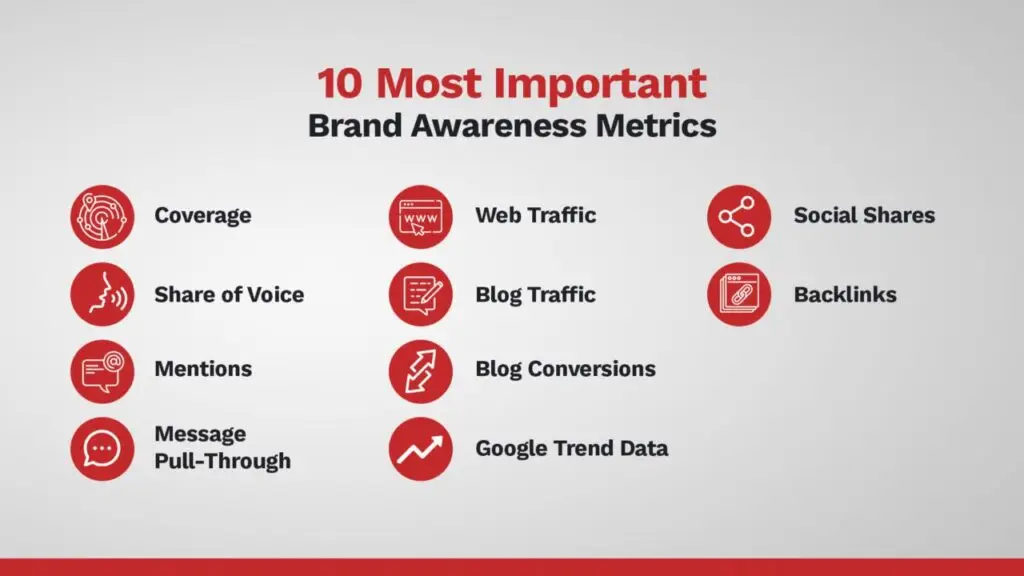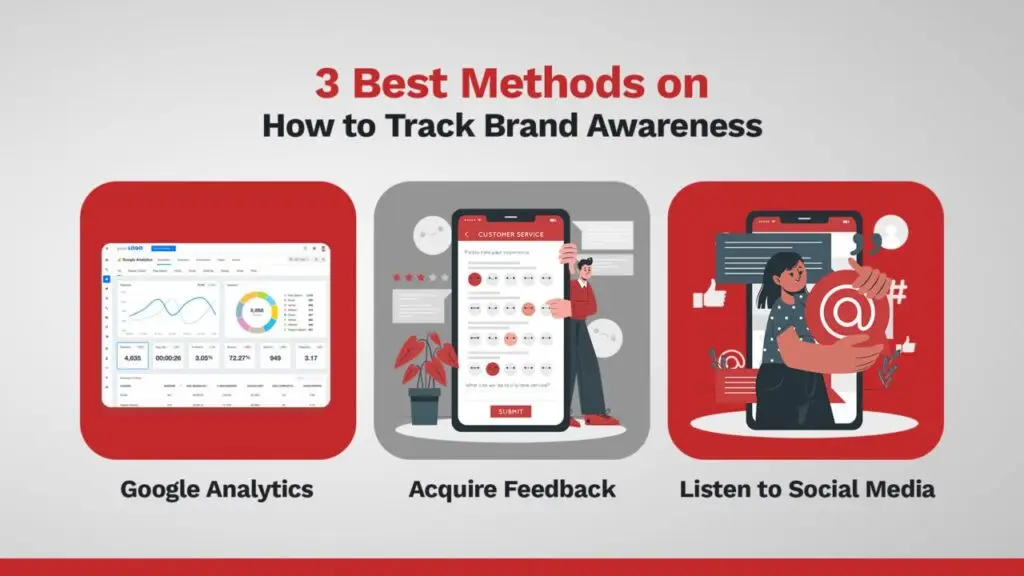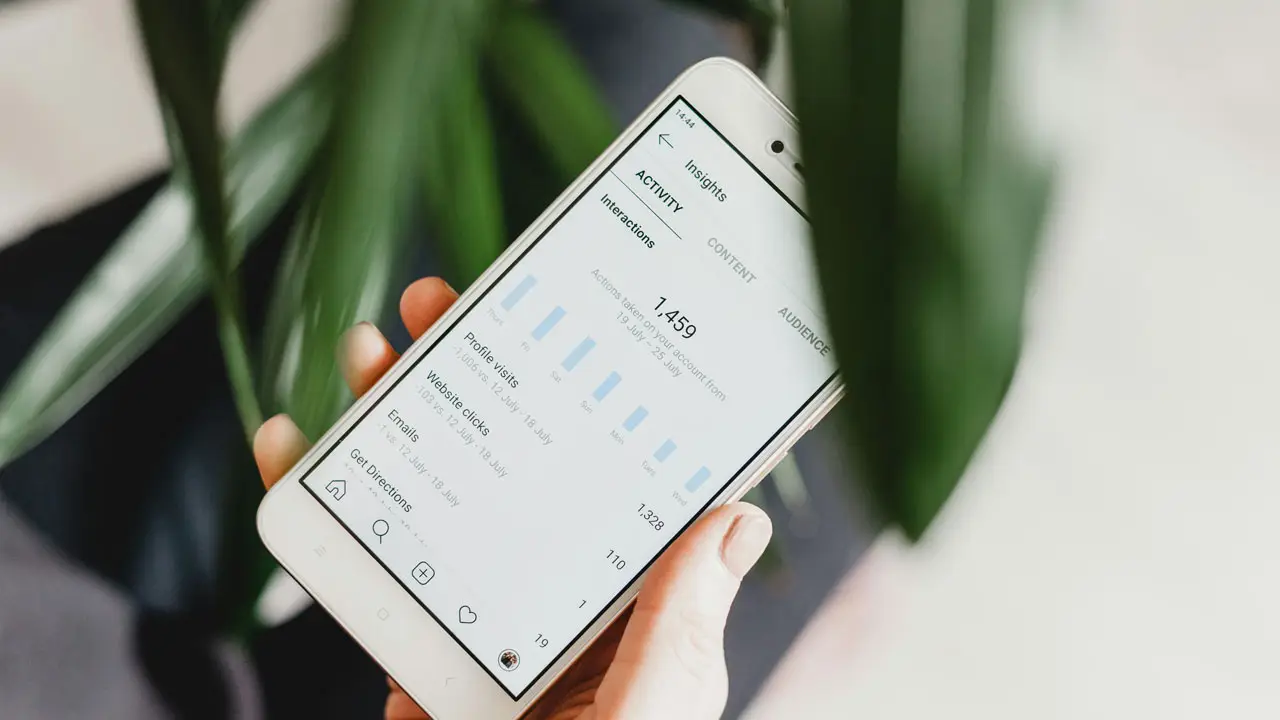Want to know how to promote and let people recognize your brand?
Brand awareness refers to the consumers’ knowledge of a specific brand or product. They are more likely to buy or recommend a business’s products to a colleague if they can recall and recognize them. Have no idea how well-known your brand is?
Keep reading as we look at important brand awareness metrics for measuring brand awareness and provide advice on picking the best ones for your campaigns.
Why Brand Awareness Metrics Are Important

Metrics for measuring brand awareness are specific measurements or information used to assess a brand’s reputation. They demonstrate whether the desired result, such as more sales or subscriptions, is being produced by your campaign. You may use this information to help you decide whether or not to update a brand campaign and what adjustments to make.
Markets worldwide see fierce competition among brands for consumers’ attention. Businesses rely on digital marketing initiatives to separate from the competition. However, only those who customers consistently recognize succeed. Thus, being recognizable and consistent is key.
10 Most Important Brand Awareness Metrics

Brand awareness measures how well-known your company is to your target market. It is typically regarded as the first and most crucial step in the purchasing process. Thus, investing your time in learning how brand awareness metrics work will be worthwhile.
You may gauge the success of your brand awareness efforts by using the following brand awareness metrics.
Coverage
You should examine total coverage each quarter, broken down into feature articles, bylines, mentions, and syndicated media attention. This makes it quicker to keep tabs on the kind of coverage you are securing, whether it’s a complete feature article about Invoca or a byline you put. There is also software that tracks every item of press and social media shares; you may give them a try.
Share of Voice
Many in the public relations industry are using the share of voice metrics. It is described as the ratio of your brand’s media and social media mentions to your competitors. Share of voice does not measure the quality of coverage but only the quantity. In order to solve this, you may look at the proportion of impressions or the number of people exposed to advertising of your business compared to that of your competitors.
You can gauge the caliber of coverage by comparing the two side by side. If your company has a low SOV but a high SOI, it may not be obtaining as much exposure as its competitors, but it is securing pieces in higher-quality articles with a more extensive reader base.
Mentions
Mentions include any instances your product is mentioned in the press, blog, or a comprehensive piece about the company. Mentions can occur when a researcher mentions your company in a larger story or when you offer them an article or a correspondent. To measure awareness and excitement, you should track the number of mentions throughout the quarters. Your mentions have grown over the quarters mostly due to the connection you have established with reporters, the exclusive data reports you have released, and more joint ventures with other tech organizations.
Message Pull-Through
Measurement of message pull-through enables you to assess the level of coverage. The company benefits directly and indirectly when important company statements are included in media coverage. If they do not notice your messages, they may not engage with the media or may not be the kinds of pieces you want to be featured in.
Web Traffic
You may use Google Analytics to examine all types of website traffic, including direct, referral, and organic. You can use this to determine whether or not people are visiting your website due to your PR and social media activities. Your organic and referral traffic will increase in the months following significant PR announcements and heavy media coverage. For instance, funding announcements, news releases at the end of the year, and the introduction of new products sometimes cause spikes. You may learn which articles are bringing visitors to your website and the caliber of those visits when you analyze the referral traffic.
Blog Traffic
Every month, you should track the total and organic blog traffic and analyze the blog posts, advertisements, and social media referrals that generated the most traffic. To identify the best sources generating visitors and focus more on promotion, you should analyze the organic and direct blog referral sources (LinkedIn, Facebook, direct email, and organic). To determine how many new users you are bringing to the site through each channel, you should also compare unique pageviews to pageviews.
Blog Conversions
If links within blog posts or CTAs at the conclusion are the sources generating such conversions, you should also look at the most popular blog content. This provides you with information about the kinds of content downloaded most frequently and the most effective ways to promote them.
You should also look at the blogs generating the most valuable conversions, such as demo requests. Then, you can develop blogs of a similar style that direct website visitors down the sales funnel and spark interest in your product.
Google Trend Data
If links within blog posts or CTAs at the conclusion are the sources generating such conversions, you should also look at the most popular blog content. This provides you with information about the kinds of content downloaded most frequently and the most effective ways to promote them.
You should also look at the posts generating the most valuable conversions, such as demo requests. Then, you can develop blogs of a similar style that direct website visitors down the sales funnel and spark interest in your product.
Social Shares
You can decide the most effective strategy to promote posts and gain more knowledge about the more well-liked post subjects by looking at the number of social shares and the social media platforms on which the blog posts are shared. It’s typically a hint that you need to produce more information around a topic if it generates a lot of talk on social media.
Backlinks
Backlinks are a crucial component of brand recognition since they demonstrate that other websites are making references to you and your goods or services. Strong backlinks are essential for search engine rankings and attracting visitors from other websites. More backlinks increase both recommendation and direct search traffic to your website.
Guest publishing on other websites with anchor text pointing back to important pages is a terrific strategy to improve the number of backlinks to your website.
3 Best Methods to Track Brand Awareness Metrics

One of the main aims of marketers is to gain new clients. You can accomplish this by placing a company’s name in front of the intended audience via social media, outdoor advertising, and other strategies. You can’t evaluate the success of your efforts without building brand awareness, or as marketers would say, “building brand awareness.”
So how precisely does one measure the success of brand awareness? I’ll demonstrate some useful techniques for measuring it and provide you with some useful advice below:
Google Analytics
As it detects user demographics, traffic sources, and audience engagement levels, Google Analytics is ideal for gauging brand awareness.
What are the main sources of traffic to your website?
I assume you already have a Google Analytics account (if not, do so now). The platform will generate statistics on where your website traffic originates so you can study the sources. Enter it and click on “Acquisition,” then locate and click on “All Traffic” and “Channels.”
There are eight major traffic channels in Google Analytics:
- Organic search
- Direct
- Display
- Referral
- Social
- Paid search
- Other
Why are there so many channels? The phrase “organic search” primarily refers to when someone conducts a Google search, your website appears in the search results, and they click the link to it. Second, the Direct channel includes various traffic sources, including browser bookmarks and mobile apps.
Next, the email channel includes traffic from email marketing, and the social channel has traffic from your social media profiles.
You can check the facts and statistics for each channel to discover how effective your awareness campaign has been. As a result, you’ll identify the areas where you’re most successful and where you need to improve your efficacy.
Acquire Feedback
Survey: Both online and offline testing of brand awareness can be done using this technique. For instance, you have certainly come across many forms on websites offering you to respond to a brief survey in exchange for free content or possibly a discount. These brief questionnaires frequently test your brand familiarity by posing a series of queries like “How did you discover about us?”
By responding to them, you assist the brand in identifying areas where they successfully promote themselves and other valuable information. You’ll explain to them, for instance, how people like you learn about them. Companies like essay writing services that interact with clients worldwide frequently employ these surveys. As a result, the brand will have some data to change its marketing plan and get the best results for brand recognition.
Review sites: All companies nowadays should keep an eye on review websites like Yelp, Google, and Yahoo because that is where customers go to learn about them. Customers can check Yelp, for instance, to see what other people say about a business if they are unsure about utilizing it. Review websites continue to be trusted sources of information for many despite specific reports claiming that many of the reviews are fraudulent.
Therefore, by visiting these sites, you’ll be able to assess how people see your company. These reviews impact how potential customers regard your business, so they can offer useful insight into how to enhance goods or services. You may also use positive endorsements and reviews to further your marketing efforts.
Listen to Social Media
Regarding assessing brand awareness, social media is one of the most significant sources of information. You may “listen” to online discussions about your business on social media and learn what customers say about it. For illustration, you can employ the measurements listed below:
Brand mentions: Customers frequently use brand names to refer to them in posts, so keeping an eye on the conversation might give you useful information. For instance, it might result in frank criticism and unbiased understanding.
Monitor brand mentions with specific keywords and phrases across your social media feeds using specialized tools like Google Alerts or Mention. Additionally, don’t restrict your analysis to naming your brand specifically. Include any probable misspellings and a list of your best-selling items.
Engagement reach: You submit content daily to your company’s social media pages, but how often is it shared? You can use applications like Sharedcount, which analyzes URL shares, likes, pins, and other metrics, to examine the reach of your social media material.
Conclusion
Although measuring brand awareness is challenging, you must do it at least once weekly to get valuable data. You may feel miserable right now from all the work that goes into assessing. However, you shouldn’t consider brand awareness extremely complicated because if you stick to the rules, you’ll get the hang of it quickly.
The advice in this article can help at that point. They should be helpful to you as you create a strategy for achievement that will ensure that your company is well-known.
